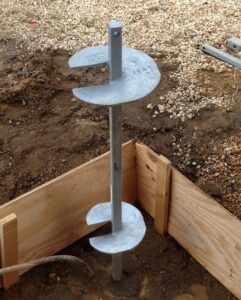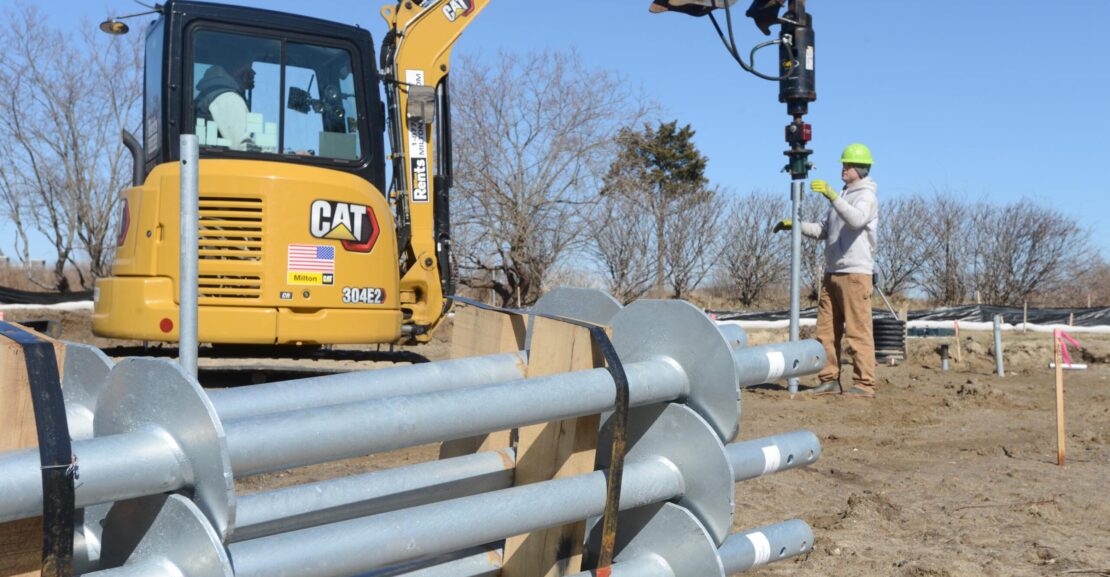In the dynamic realm of construction, where innovation continually shapes the way we build, helical piles have emerged as remarkable tools revolutionizing foundation engineering. These spiral-shaped, steel-forged marvels have gained prominence for their versatility, efficiency, and adaptability to various construction scenarios. Let’s delve deeper into the world of helical piles, exploring their unique design, advantages, and the wide array of construction applications where they shine.
Understanding Helical Piles:
At their core, helical piles consist of a central steel shaft with helical flights, resembling a large screw or auger. The unique design enables these piles to be installed with precision and effectiveness. They are screwed or rotated into the ground, creating a stable foundation.
The Advantages of Helical Piles:
 1. Versatility: Helical piles are incredibly versatile, making them suitable for a wide range of construction applications. They can be used for both compression and tension applications, making them valuable in various project scenarios.
1. Versatility: Helical piles are incredibly versatile, making them suitable for a wide range of construction applications. They can be used for both compression and tension applications, making them valuable in various project scenarios.
2. Speed and Efficiency: Installation of helical piles is often faster and more straightforward compared to traditional deep foundation methods like concrete piers or driven piles. This efficiency can lead to significant cost savings.
3. Minimal Environmental Impact: Helical piles generate minimal soil disturbance during installation, reducing the environmental footprint of construction projects. This is especially crucial in sensitive or restricted areas.
4. Load Capacity: These piles are designed to support substantial vertical and horizontal loads, making them suitable for both residential and commercial structures.
Common Uses in Construction:
1. Residential Foundations: Helical piles are increasingly used in residential construction for supporting foundations. They are particularly valuable in regions with challenging soil conditions.
2. Commercial Buildings: In commercial construction, helical piles are used to support a wide variety of structures, including office buildings, warehouses, and retail spaces.
3. Boardwalks and Decks: Helical piles provide stable support for elevated structures like boardwalks, decks, and observation platforms, even in coastal or environmentally sensitive areas.
4. Utility Poles and Towers: They are utilized to secure utility poles and transmission towers, ensuring their stability and reliability.
5. Bridges and Retaining Walls: Helical piles can be used in bridge construction and retaining walls, where their load-bearing capacity and efficiency are advantageous.
6. Renewable Energy Installations: Wind turbines and solar panel arrays often require helical piles for anchoring, especially in remote or uneven terrains.
7. Underpinning and Foundation Repair: When existing foundations need reinforcement or repair, helical piles offer a cost-effective and minimally invasive solution.
8. Emergency Response: In disaster-stricken areas, helical piles are used to quickly stabilize structures, allowing for faster recovery efforts.
Installation and Considerations:
Proper installation of helical piles is critical to their effectiveness. It requires specialized equipment and skilled personnel who are trained to assess soil conditions and calculate the appropriate pile size and depth.
Conclusion:
Helical piles represent a significant advancement in foundation engineering, offering a versatile, efficient, and environmentally friendly solution for various construction needs. As the construction industry continues to evolve, helical piles are likely to play an increasingly prominent role in shaping the foundations of our built environment. Whether supporting residential homes, towering commercial buildings, or renewable energy installations, these innovative piles are proving invaluable in modern construction. As we look to the future, it’s clear that helical piles will remain a vital tool for architects, engineers, and builders seeking stability and sustainability in their projects.
Helical Piles | what are common construction uses?
This article explores how helical piles, with their spiral design, are revolutionizing modern construction. These versatile steel foundations offer numerous advantages, including speed, minimal environmental impact, and robust load-bearing capacity. Commonly used in residential and commercial projects, as well as for underpinning and emergency response, helical piles provide stability and reliability in challenging soil conditions. Proper installation by skilled personnel is essential. As construction practices evolve, helical piles are set to play a pivotal role in shaping the foundations of sustainable and efficient buildings.
